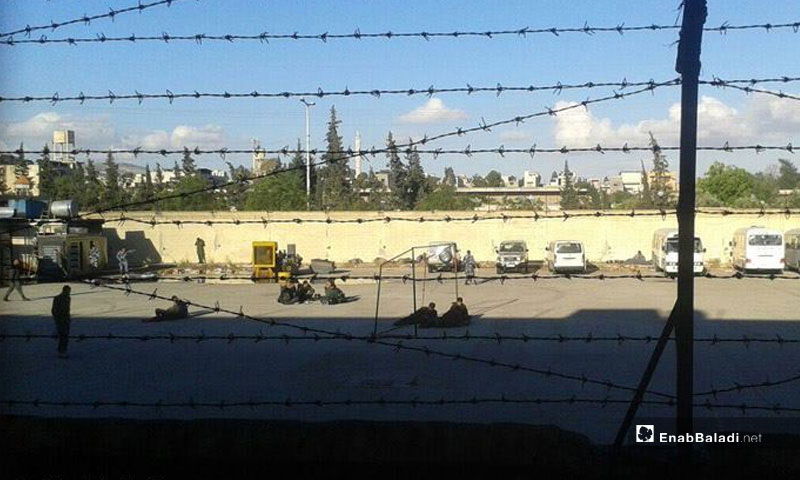Numerous were the strikes and protests that the Hama Central Prison witnessed late in 2018, where the inmates protested the death sentences passed against some of the detainees, succeeded by a set of decisions that led to the Syrian regime’s release of dozens of inmates, in a step encompassed by much suspicion and question marks, which wondered at the regime’s goal of setting the detainees free.
On March 20, 2019, the Syrian regime released a large batch of Hama Central Prison’s inmates, including 50 persons held in captivity since 2011 for participating in the popular demonstrations against the regime. Since November 2018, the number of released detainees amounted to 106 inmates.
Political and Media Pressure
Lawyer Abdulnaser Houshan, a member of the “Syrian Legislators Committee”, said that the strikes which the Hama Central Prisons’ inmates embarked on in 2016, in protest against the sentences passed by the Terrorism Court and the Field Court against them, took the prison out of the regime’s control back then.
In a statement to Enab Baladi, al-Houshan added that the strikes, accompanied by riots inside the prison, prevented the prison’s officials and elements from entering the cells, because the prisoners’ actions were “excellently” covered by the media and legal entities, which inflated with the prisoners’ embarking on a hunger strike in November 2018.
On November 12, 2018, the inmates of Hama Central Prison embarked on a hunger strike refusing the death sentences passed by the Field Court against 11 of them, against the background of their participation in the peaceful demonstration of 2011. The strike lasted for about a month.
The detainees were informed of the sentence by the Single Military Judge in Hama, Ferass Dunia.
According to Houshan, the Security Committee in Hama sent a delegation consisting of the area’s renowned figures to convince them to end the hunger strike without conditions, but the detainees insisted on their demands of annulling the death sentences and the release of the detainees whose prison period ended. However, the regime refused to answer their calls.
The rapid developments necessitated that the delegation communicates directly with the Khmeimim Air Base, which contacted the concerned authorities in Moscow informing them of the situation inside Hama prison. The “Syrian Legislators Committee”, for its part, filed a human rights report to the Independent International Commission of Inquiry on Syria, supported by recorded testimonies of detainees inside the prison.
All of this, according to the Syrian lawyer, imposed pressure on the Syrian regime and necessitated the release of 106 detainees, who have all ended their imprisonment sentences or three-quarters of it, in addition to a few who were sentenced to death.
Sentences against a number of detainees were commuted from death to rigorous imprisonment for life, while life sentences were commuted to 15 years of rigorous imprisonment.
The 106 detainees were released in five batches, the first, and the second just like it, included 18 detainees, the third consisted of two prisoners only, the fourth included 18 detainees; on the fifth, the largest, 50 detainees were released.
Suspicious Assent
Against its opposers, the Syrian regime followed the policy of arbitrary detention and enforced disappearance since 2011, when the public demonstrations broke out, given that there are no less than 210 thousand detainees and forcibly disappeared persons in its prisons, according to the statistics of the Syrian Network for Human Rights, who are being subjected to torture while the regime refuses to admit having detained them.
Questions, thus, encompassed the goal behind the regime’s assent to the demands of the inmates of the Hama Central Prison, which Abdulnaser Houshan, a member of the “Syrian Legislators Committee”, attributed to the pressure imposed by the Russians on the Syrian regime, helped by the detainees’ hunger strike and the media coverage, which did not happen elsewhere in other Syrian detention centers.
Houshan added that the Syrian regime exploited the whole affair by saying that it released the detainees of the Hama Central Prison under a presidential pardon decree, but the majority of the released detainees were of those who have already ended their sentence’s duration, in addition to this, the “pardon” which the regime alleged issuing did not extend to detainees in other prisons.
The Syrian lawyer, informed of the state of the detainees in the Hama prison, pointed out that the administration of the prison resorted to coercing the released detainees to undergo a settlement that guarantees their release in return for their joining the mandatory or reserve military service under the forces of the Syrian regime.
In the Hama Central Prison, 70 persons are yet held in captivity, sentences were passed against some of them, while others have been placed in preventative custody for more than six years.
The released, however, failed to leave the areas of the Syrian regime towards those controlled by the opposition, fearing that they might be subjected to detention once more.

